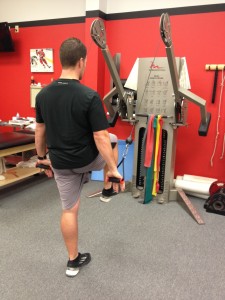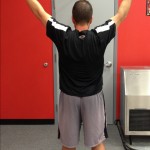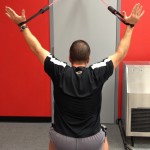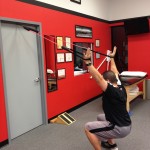Brian Schiff’s Blog
Injury Prevention, Sports Rehab & Performance Training Expert
This post is the third corrective exercise in a series I am doing for Personal Fitness Professional Magazine in my online column titled “Functionally Fit.” To read more online exercise tips, visit www.fit-pro.com.
The hurdle step assessment (as part of the FMS) is designed to challenge the body’s proper stepping and stride mechanics as well as stability & control in single leg stance. The step leg must perform ankle DF and hip/knee flexion while core stability must be present in single leg stance.

Limited hip mobility and/or poor hip and core stability restricts natural movement and leads to compensatory motion often in the form of unwanted hip rotation, hip hiking, trunk sway in the frontal and sagittal plane. A common corrective exercise prescribed to improve core stability is a standing march (single leg stance) with straight arm pulling to engage the core.
Execution: Begin standing with the feet together while holding the cable handles with the palms down. Select a weight that provides ample enough resistance to maintain isometric shoulder extension for 30-60 seconds. Be careful not to select too little or too much weight as this will disrupt the execution of the exercise.
Next, pull the arms down toward the side and hold in that position. Maintaining an erect posture, slowly lift the left leg up (ankle dorsiflexion with knee and hip flexion) and pause for 2-3 seconds. Move the unsupported leg back to the start position but keep the arms actively extended. Repeat this sequence for 10 times on the left leg. Rest for 30-60 seconds and then repeat on the other leg. Perform 2 sets.

Additional notes: I tend to focus on unilateral consecutive repetitions (as described above) especially if there is a 2/1 asymmetry with the hurdle step. As the asymmetry is resolving, I will progress to a reciprocal pattern as this is more natural in life/sport. If a cable column is unavailable, alternate methods include using a suspension training apparatus or resistance tubing anchored high enough to accomplish the same upper body isometric pulling.
Application: Poor hip stability and control in single leg stance is a common cause of overuse injuries in runners and contributes to increased risk for anterior knee pain and ACL injuries. Keep in mind that poor performance on the hurdle step movement can be related to weak hip flexors on the stepping leg, tight hip flexors on the stance leg, diminished hip stability and poor balance.
It is critical to assess the whole movement prior to assuming that there is just one problem or weak link in the kinetic chain. Restoring symmetric, optimal stepping patterns will promote proper hip disassociation, as well as training the body to synergistically activate core and hip musculature to demonstrate optimal single leg stability in unilateral stance.
This is the second installment of corrective “go-to” exercises I am highlighting here and in my online column for PFP magazine. Click here to read the post on resisted overhead squats. The in-line lunge allows for the observer to pick up flaws or asymmetry by placing the body in a narrow stance with a wide stride to assess hip, knee, ankle and foot mobility and stability of the client. It places the upper and lower extremities in alternate asymmetrical patterns.
Limited mobility or hip disassociation will produce movement dysfunction with the in-line lunge (see picture below for how it is assessed during the FMS).

A common corrective exercise prescribed to improve mobility is the leg lock bridge.
Execution: Begin in supine flexing one leg up to the chest. Hold the flexed leg against the chest while keeping the extended (down) leg in line with the center of the body and the knee flexed. A small ball (pictured below), pillow or towel roll may be placed between the thigh and chest for tactile feedback regarding the lock position.
Next, push down through the extended leg on the floor to elevate the hips off the ground into a bridge. The height of the bridge should be limited to the point where contact can be maintained between the thigh of the flexed hip and the chest keeping the extended hip/thigh in the in-line position. Perform 2-3 sets of 10-15 repetitions.

Application: The ability to stride in a lunge position without forward trunk lean during the in-line lunge can be inhibited by tight hip flexors. Soft tissue work and stretching is certainly helpful, but this active mobility exercise will improve reciprocal movement and facilitate hip disassociation. It is a great exercise to include as part of your corrective exercise series and/or movement and pillar prep work with your clients.
If clients struggle or experience hamstring cramping, consider adding a small step beneath the foot of the extended leg to increase the hip flexion starting position. Modifications and adjustments to sets, repetitions and distance between the flexed thigh and chest as well as the extended foot and ground should be considered with exercise prescription.
I am currently writing up a series of corrective exercises related to the Functional Movement Screen (TM) that shows some common “go to” corrective drills I use on a regular basis. So, I will include those in my blog as I go since many people will benefit from the exercises to maximize mobility and stability.
I started off with a Deep Squat corrective exercise. If you are unfamiliar with the FMS, feel free to send me an email and I will send you a copy of a basic in-service I did on it to give you a better picture of the screening movements. Many issues can impact the overhead squat. While I often find ankle and hip mobility to be the primary limiting issues, an overlooked problem may include poor scapulothoracic stability. The resisted overhead squat will help correct deficiencies in that region.
Execution: I prefer to use a Cook band for this drill, however, you may also opt for tubing with handles or a TRX. The important thing is to use a partner or have whatever equipment you use firmly and safely anchored so you can squat without it giving way.
Begin in an upright position while looping the straps/handles over the back of the wrists or grabbing the handles with palms facing away from you. Slowly squat down as you actively retract the scapulae while keeping the arms in an overhead position. Pause at the bottom and return to upright. Adjust the distance from the anchor point to achieve the proper resistance level, keeping in mind that too much resistance will compromise form and result in a forward trunk lean.
Application: This is a very effective training exercise to facilitate proper scapulothoracic muscle activation. If a client has latissiumus, pec or teres major tightness, performing soft tissue mobilization beforehand is suggested. Cueing the client to actively pull the shoulder blades “down and back” is helpful in many cases. In many cases, they are so upper trap dominant they do not use proper motor patterns with overhead activity.
Regression: Instruct the client to do a forward facing overhead squat near a wall. Let them move close enough to where their fingertips nearly or just touch the wall at the bottom of the squat. The cues for muscle activation remain the same.
Progression: In the bottom of the overhead squat, instruct the client to hold while the trainer will provide some light perturbations of the bands to maximize neuromuscular activation and further groove the right pattern. Form should guide how much perturbation and once fatigue begins to impact control the exercise should stop. You may do fewer repetitions with this more advanced exercise.
I wanted to send out warm wishes for a great Holiday to all my readers. I am blessed to write, speak, rehab and train people in my daily work – all things I love to do. Education and sharing information is the primary motivation behind my blogging as I want to help others achieve optimal health, performance and recovery. To that end, my sincere hope is that this blog continues to be a quality source of information for you and your family/friends.

This is also a time of year when I like to offer discounts on my educational products as a way of giving thanks. So, through midnight on Cyber Monday (12/2/13) I will be offering a discount on all my DVD’s, e-books, and books (Trigger Point products, online consulting and pulley not included). So, from now until Monday at midnight, you can save 25% on these products by entering coupon code BFIT25 at checkout.
I hope you have a wonderful time with family and friends during this Holiday time and wish you continued health and prosperity moving forward.
As someone who works with high level athletes and those aspiring to take their performance to new levels, I think it is important to understand power development and the real “why” behind the exercises we choose. I also come at this from the side of a sports physical therapist who is working to get athletes back to their peak performance.
To that end, I am always looking for the most effective ways to train the neuromuscular system. Finding the most “specific” exercises for our clients is important. I thought I would provide a brief summery of a new article in the November 2013 Journal of Strength and Conditioning Research that looked to compare the neuromuscular characteristics of two types of jumps: hurdle and drop jumps. In addition, the authors wanted to examine three types of landing techniques:
- Preferred – athlete instructed to jump with a technique that allows for jumping as quickly and high as possible
- Flat foot
- Forefoot (FORE)
The working hypothesis was that hurdle jumps would be more powerful than drop jumps (DJs) and that foot flat technique would decrease mechanical power. The study included 25 subjects (male athletes) from Memorial University and during the jumps reaction forces, contact time, rate of force development (RFD) and lower limb EMG were measured.
All subjects did regular regular resistance training multiple plyometric drills with a typical volume of > 100 repetitions per session. However, none of the subjects had done drop jumps before. As such, this was the first test assessed to avoid fatigue. Subjects stood on a force platform and were asked to perform a maximal CMJ. Two trials were conducted with 1 minute of rest in between jumps. The maximum CMJ height was used to establish the DJ and hurdle height. The average flight time of the two trials was used to calculate jump height.
The order of DJ and hurdle jump tests was randomized with 5 minutes of rest between the jumps. The athletes did a 10 minute warm-up of cycling at 75 W-60 RPM followed by 5 sets of 5 sub maximal hopping, 5 single submaximal CMJ and 2 maximal CMJ. Only dynamic stretching was allowed during the warm-up to avoid any muscular power deficits created by static stretching.
Results
Contact time
- Hurdle jump had a 36.9% shorter contact time compared to DJ
- Preferred technique 29.1% shorter contact time than FLAT
- Preferred technique had 9.6% longer contact time than FORE
- FLAT 25.9% longer than FORE
- Jump and landing type interaction 23.8% shorter ground contact time for DJ FORE vs. FLAT
Vertical ground reaction forces (VGRF)
- Hurdle jump forces were 11% higher than DJ
- FLAT techniques revealed 30.8% less reaction force than preferred technique and 40.9% less than FORE
- DJ preferred technique had 14.9% more force than DJ FLAT
- DJ FLAT had lowest force level and was 25.9% less than DF FORE
Rate of force development
- Main effect of hurdle jump showed 46.3% higher RFD than DJ
- FORE technique 11.3% higher than preferred and 45% higher than FLAT
- Preferred technique 38% higher than FLAT
- DJ preferred 35% > DJ FLAT
- Hurdle jump preferred 40.9% higher than DJ preferred
- Hurdle jump FORE 43.6% higher than DJ preferred
- DJ FLAT was lowest for RFD
Leg stiffness
- Hurdle jumps were 64% stiffer than DJ
- Hurdle jump FORE had greatest stiffness
- DJ FLAT was the least stiff technique
EMG Activity
- Rectus femoris – HJ had 30% higher activity than DJ, eccentric phase highest, and FLAT higher than preferred and FORE
- Biceps femoris – HJ 68.8% more activity than DJ, concentric phase highest, and preferred higher than FLAT
- Tibialis anterior – FLAT had highest activity, eccentric phase highest
- Gastrocnemius – Preferred 26.3% > FLAT, FLAT 47% < FORE, and concentric phase highest
Key findings of the study
- Preferred and FORE hurdle jumps were more powerful plyometric exercises than the DJ based on a shorter contact time, higher VGRF, RFD and leg stiffness
- FORE and preferred landings produced the best results for all mechanical power variables




